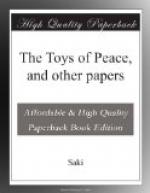On Easter Saturday Harvey Bope unpacked a large, promising-looking red cardboard box under the expectant eyes of his nephews. “Your uncle has brought you the newest thing in toys,” Eleanor had said impressively, and youthful anticipation had been anxiously divided between Albanian soldiery and a Somali camel-corps. Eric was hotly in favour of the latter contingency. “There would be Arabs on horseback,” he whispered; “the Albanians have got jolly uniforms, and they fight all day long, and all night, too, when there’s a moon, but the country’s rocky, so they’ve got no cavalry.”
A quantity of crinkly paper shavings was the first thing that met the view when the lid was removed; the most exiting toys always began like that. Harvey pushed back the top layer and drew forth a square, rather featureless building.
“It’s a fort!” exclaimed Bertie.
“It isn’t, it’s the palace of the Mpret of Albania,” said Eric, immensely proud of his knowledge of the exotic title; “it’s got no windows, you see, so that passers-by can’t fire in at the Royal Family.”
“It’s a municipal dust-bin,” said Harvey hurriedly; “you see all the refuse and litter of a town is collected there, instead of lying about and injuring the health of the citizens.”
In an awful silence he disinterred a little lead figure of a man in black clothes.
“That,” he said, “is a distinguished civilian, John Stuart Mill. He was an authority on political economy.”
“Why?” asked Bertie.
“Well, he wanted to be; he thought it was a useful thing to be.”
Bertie gave an expressive grunt, which conveyed his opinion that there was no accounting for tastes.
Another square building came out, this time with windows and chimneys.
“A model of the Manchester branch of the Young Women’s Christian Association,” said Harvey.
“Are there any lions?” asked Eric hopefully. He had been reading Roman history and thought that where you found Christians you might reasonably expect to find a few lions.
“There are no lions,” said Harvey. “Here is another civilian, Robert Raikes, the founder of Sunday schools, and here is a model of a municipal wash-house. These little round things are loaves baked in a sanitary bakehouse. That lead figure is a sanitary inspector, this one is a district councillor, and this one is an official of the Local Government Board.”
“What does he do?” asked Eric wearily.
“He sees to things connected with his Department,” said Harvey. “This box with a slit in it is a ballot-box. Votes are put into it at election times.”
“What is put into it at other times?” asked Bertie.
“Nothing. And here are some tools of industry, a wheelbarrow and a hoe, and I think these are meant for hop-poles. This is a model beehive, and that is a ventilator, for ventilating sewers. This seems to be another municipal dust-bin—no, it is a model of a school of art and public library. This little lead figure is Mrs. Hemans, a poetess, and this is Rowland Hill, who introduced the system of penny postage. This is Sir John Herschel, the eminent astrologer.”




